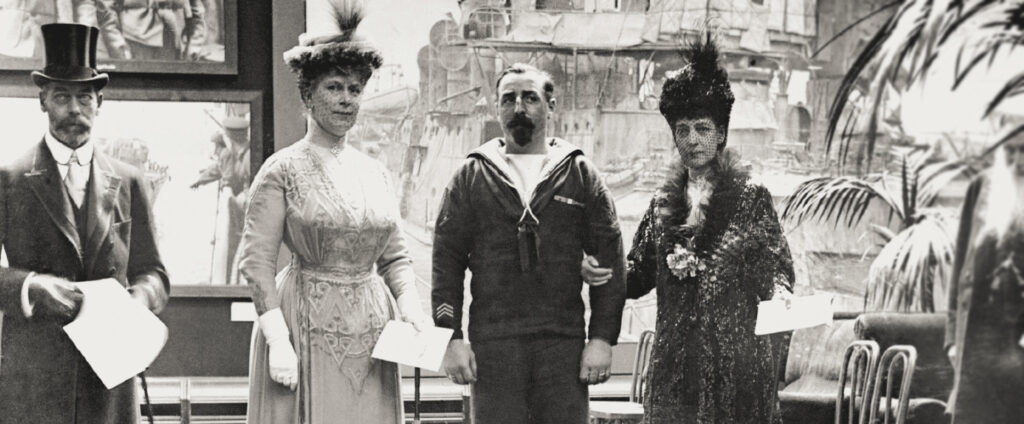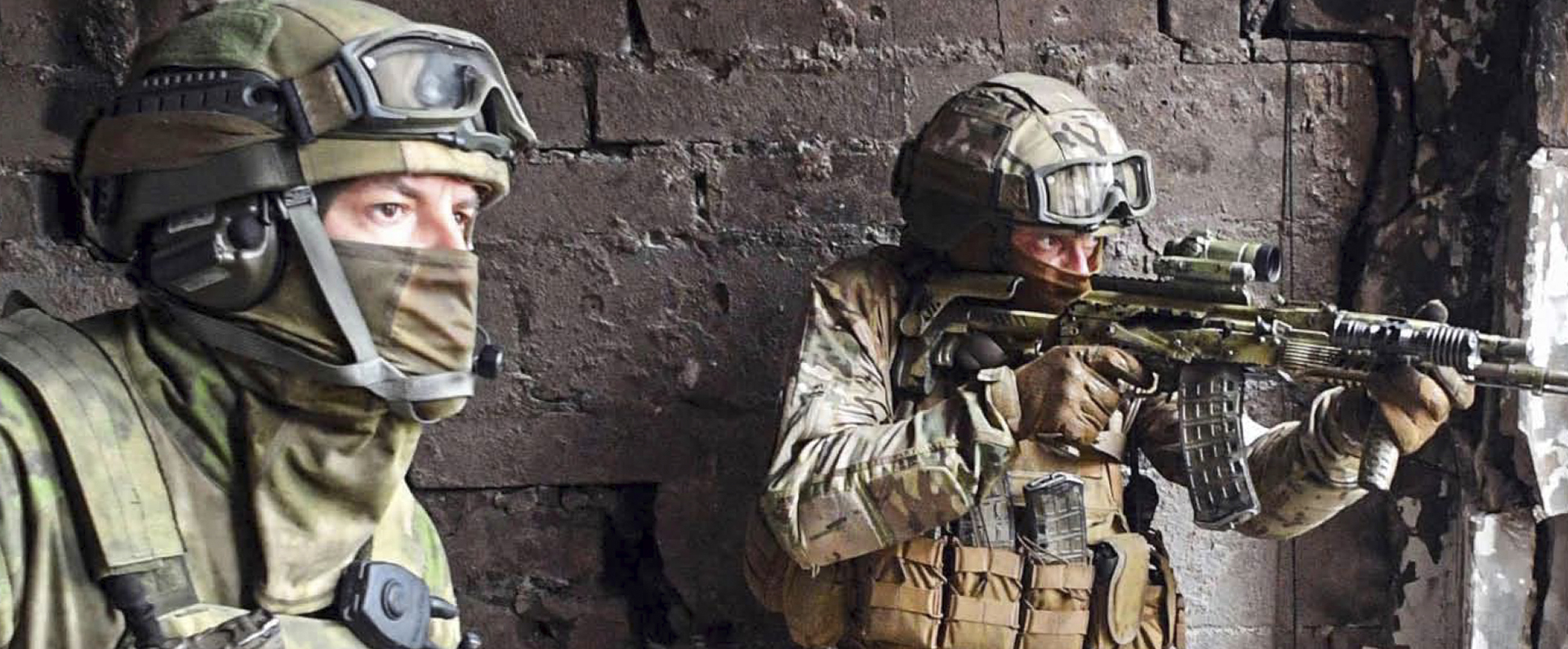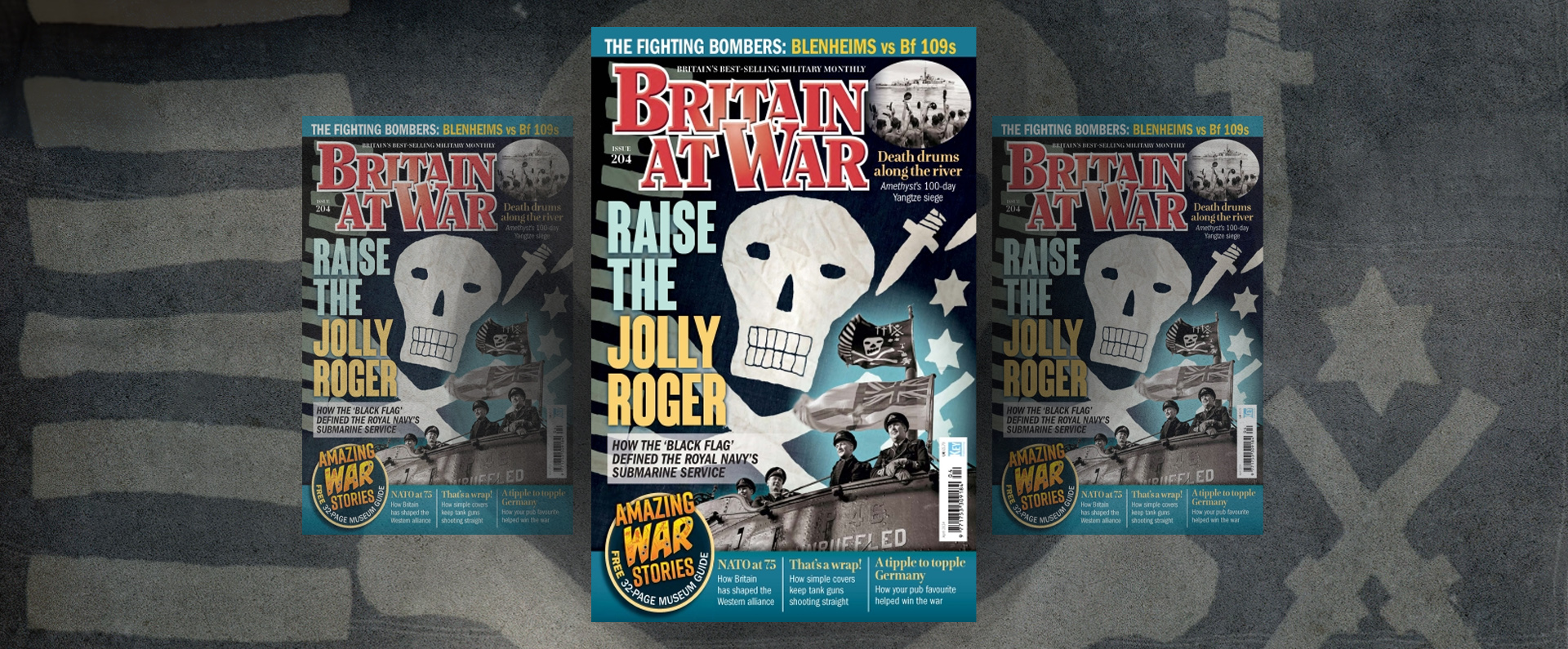
Published in Britain at War in February 2023.
Chief Petty Officer Ernest Herbert Pitcher VC, DSM
The momentous events on board HMS Dunraven in the summer of 1917 changed the life of Ernest Pitcher for ever. He was only too happy to acknowledge this fact and he even named both his daughter and his house, “Dunraven”, in the years after the First World War ended.
Ernest Herbert Pitcher was born in Mullion, Cornwall, on December 31 1887. He was the son of George Pitcher, a coastguard, and his wife Sarah (née Beverstock). When he was a young boy, his parents moved to Dorset where his father continued to work as a coastguard and young Ernest Pitcher attended Swanage Board School.
Pitcher left school at a young age, believed to be around 13, and initially worked as a plumber’s mate. However, he joined the Royal Navy at the age of around 14, in the rank of Boy 2nd Class, initially serving in HMS Boscawen. In February 1904, Pitcher was promoted to Boy 1st Class and the following summer he served in HMS Vernon, a “stone frigate”. From September of the same year, he served in HMS Terrible, a cruiser, followed by other postings. At the outbreak of the war in August 1914, Pitcher was serving in HMS King George V, the flagship of the Second Battle Squadron.
The following year, he volunteered for service in the expanding Q-ship fleet, at one stage Britain’s answer to German U-boats, which had caused terrible damage to the Allies’ merchant fleets in the early stages of the war. After the U-boats had proved their supremacy at sea, a pattern had emerged whereby a U-boat, to preserve costly torpedoes and allow it to plunder its target’s valuables, would surface close to a merchant ship and accept the soft target’s surrender. The merchant crew would then leave their ship to the German submariners, who would take any valuables that took their fancy before scuttling it. The Q-ship, an armed decoy ship disguised to look like a merchant ship, was devised to combat this practice. As soon as the U-boat surfaced and came into range, hitherto hidden guns were uncovered and the Q-ship would attempt to blow it out of the water.
The Q-ships were crewed largely by men from the Royal Navy Reserve but bolstered by regulars from the Royal Navy with experience in gunnery. By the time Pitcher was serving in Q-ships, he had received two further promotions, first to Leading Seaman and then to Petty Officer. Pitcher initially served in the ex-collier Loderer, which became known as HMS Farnborough, or Q.5. In fact, Loderer was renamed Farnborough after the Admiralty received an anonymous tip-off that her new role as U-boat bait had been leaked to the Germans.
The ship, which had been built in 1904, was fitted out at the naval dockyard in Devonport, Plymouth, with the typical devices of a Q-ship: five twelve-pounder guns variously concealed by a “steering house” aft, hinged flaps on the main deck and dummy cabins on the upper deck; two six-pounder guns hidden at either end of the bridge; and a Maxim gun in a dummy hencoop amidships. There were 11 officers and 56 men on board, with Pitcher one of the few regular Royal Navy ratings.
On March 22 1916, Farnborough made the fourth Q-ship U-boat “kill” of the war when she sank Kapitan-Leutnant Guntzel’s U.68 with all hands. This success led to the Q-ship’s captain, Lieutenant Commander Gordon Campbell, being promoted to commander and awarded the Distinguished Service Order (DSO). On February 17 1917, to the west of Ireland, Farnborough accounted for her second kill, U.83, which was sunk with the loss of all hands bar an officer and one seaman. Campbell was awarded the Victoria Cross (VC) and Pitcher was Mentioned in Despatches.
Shortly afterwards, Pitcher and most of the rest of Q.5’s crew elected to follow Commander Campbell to his next Q-ship: another former collier which was renamed HMS Pargust. She had improved equipment and armaments, including a four-inch gun, and went to sea in May, but she was torpedoed a month later by Kapitan-Leutnant Rose’s UC.29. The decoy “panic party” left the ship and when the U-boat surfaced the remaining crew fired 38 shells at it, causing it to blow up and sink. Pargust, which had been damaged in the attack, was towed into a nearby port the next day but her crew survived the attack. Under Rule 13 of the VC Royal Warrant, an officer and a rating were each awarded the VC on behalf of the whole crew, while Commander Campbell was promoted to captain and received a bar to his earlier DSO.
Pitcher was awarded one of eight Distinguished Service Medals (DSMs) for this June 1917 action. By this point, he was regarded as one of Campbell’s most dependable and steadiest crew members. As a gun captain, Pitcher was cool and calm, capable of keeping his nerve and of doing a highly-dangerous job even under a heavy enemy fire.
Most of Pargust’s crew followed Campbell on to his next command, the Dunraven. At 10.58 am on August 8 1917, their new ship, disguised as a British merchant vessel, was zigzagging some 130 miles offshore in the Bay of Biscay when a U-boat was sighted on the horizon. Dunraven maintained her course as the U-boat, UC.71, closed. At 11.17 am, the enemy submarine dived, then resurfaced 5,000 yards away on the starboard quarter. The U-boat opened fire at 11.43am and Campbell, acting in the manner of a panicking merchant captain, sent out a distress signal giving the ship’s position. He also fired off some token rounds from the ship’s little two-and-a-half pounder gun, as if it were the only weapon he possessed. The U-boat closed again and, when a torpedo almost hit Dunraven, the crew generated a cloud of steam to simulate boiler trouble.
At the same time, Campbell dispatched a “panic party” to make it look as if the ship was being abandoned. The submarine then scored three quick hits on Dunraven’s poop. The first detonated a depth charge which wounded three men and cut communications between Pitcher, the captain of the four-inch gun crew, and the bridge. However, Pitcher’s team decided not to move, since leaving the ship would have given the game away. It was imperative that the Germans had to remain convinced that the ship had already been abandoned. The second and third shells started a major fire which meant Pitcher and several others were now concealed on a “red-hot deck”.
They lifted boxes of cordite off the deck and on to their knees in a bid to stop them exploding, but still they did not flee. At that point, UC.71 was obscured by black smoke from Dunraven’s stern, which presented Campbell with a dilemma. He knew an explosion on his own vessel was inevitable, but if he delayed in giving the order to abandon ship he might get a clear shot at the submarine. He later wrote: “To cold-bloodedly leave the gun’s crew to their fate seemed awful, and the names of each of them flashed through my mind, but our duty was to sink the submarine. By losing a few men we might save thousands not only of lives but of ships and tons of the nation’s requirements. I decided to wait.”
The inevitable explosion on Dunraven came at 12.58 pm, before the U-boat could be fired upon. It blew out the stern of the ship and propelled the four-inch gun and its crew into the air. The gun landed on the well-deck and one man was thrown into the sea, while Pitcher and another crewman landed on mock railway trucks made of wood and canvas, which cushioned their falls and saved their lives.
As UC.71 crash-dived, two shots were fired at her but without any telling effect. Pitcher and the other wounded men were then removed to the cabins, where they stayed for the rest of the action with “shells exploding all around them”. As Campbell was preparing a torpedo attack, Dunraven was shelled abaft the engine room. Then the U-boat resurfaced and for 20 minutes shelled the Q-ship until diving again at 2.50 pm.
Campbell responded by firing two torpedoes. Both missed but, fortunately for Dunraven’s crew, the U-boat had by this point exhausted its own supply of torpedoes and fled the scene. A British destroyer, HMS Christopher, towed the battered Q-ship towards Plymouth but, as the weather deteriorated, she sank at 3 am. Many bravery awards were made to the crew of the Dunraven, with the VC assigned specifically to Pitcher’s gun crew going to him after a ballot to see who should receive it. The officer to receive the VC under the same rules was Lieutenant Charles Bonner and both decorations were announced in The London Gazette on November 2 1917. Campbell was awarded a second bar to his DSO.
However, this double VC action involving Dunraven was a turning point. Three weeks after her sinking, it was agreed that there was a stalemate in this form of warfare, and the Q-ship service was wound down.
Pitcher received his VC from George V at an investiture at Buckingham Palace on December 5 1917. He was also decorated with the French Médaille Militaire and the Croix de Guerre. He was treated as a hero for the rest of his life and was a striking figure with his dark beard.
Pitcher survived the war and in 1918 he married Lily Evers in Wareham, Dorset. The couple went on to have a daughter, who was christened Ruth Mary Dunraven Pitcher. On August 1 1920, Pitcher was promoted to Chief Petty Officer. He retired from the Royal Navy on December 30 1927 after a quarter of a century’s service. His retirement also came just a day before his 40th birthday. Pitcher then worked in Swanage as a woodwork teacher in a boys’ preparatory school. For a time, he also ran a pub, the Royal Oak in Herston, Dorset.
However, after the outbreak of the Second World War, Pitcher rejoined the Royal Navy on August 5 1940, and served on shore for five years at Poole, Portland and Yeovilton. His final years were spent at his home, called Dunraven, in Richmond Road, Swanage. He died at the Royal Naval Auxiliary Hospital in Sherborne, Dorset, on February 10, 1946, aged 58.
He was buried at Northbrook Cemetery, Swanage, where his Commonwealth War Graves Commission headstone bears an image of the VC and is engraved with the words, “At the going down of the sun and in the morning, we will remember them.” A memorial tablet in Pitcher’s honour was unveiled at Swanage Parish Church on Armistice Day, 1963. I am the proud and humble custodian of his medal group having purchased it at a Dix Noonan Webb auction in 1988.
Download a PDF of the original Britain At War article.
For more information, visit:
LordAshcroftOnBravery.com


